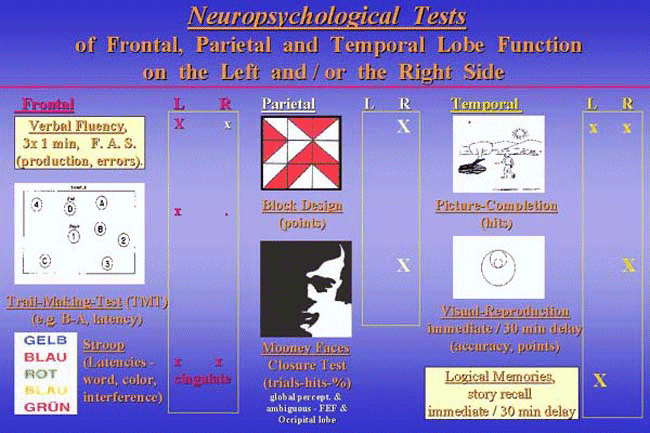|
OADES, R. D., MÜLLER, B. W., BENDER, S.,
& SARTORY, G. (2001) Neuropsychological
indicators of heteromodal cortex (dys)function relevant to conditioned
blocking measures of attention in schizophrenia. Cognitive Neuropsychiatry,
6, 41-61. - (
request a copy)
In accord with our understanding of journal policy,
we present the pre-publication
text (view). The original publication (cited above: ISSN 1354-6805,
Online ISSN: 1464-0619) is available at http://www.ingentaconnect.com/content/psych/pcnp/2001/00000006/00000001/art00004
Background.
Learning a predictive relationship
between two events can block learning about an added event (conditioned
blocking, CB). Patients with nonparanoid schizophrenia can show reduced
CB and learn about the similar consequences of the added event. What
parts of the brain are involved in the functions required in learning
the CB task and actually showing 'blocking' - a part of normal selective
attention processes? As a first approximation, we ask if neuropsychological
test performance sensitive to specific cortical regions is associated
with these two functions.
Methods.
This study reports on the relationship of associative learning and
CB measures of attention obtained with a visuospatial maze-like task
to signs of heteromodal cortex function provided by performance on a
battery of 10 neuropsychological tasks. These tasks were sensitive to frontal, parietal and
temporal lobe function of the left and right hemisphere. Acquisition
criteria for the task were achieved by 62 patients with schizophrenia
and 62 matched controls but not by 39 other people with schizophrenia. These tasks were sensitive to frontal, parietal and
temporal lobe function of the left and right hemisphere. Acquisition
criteria for the task were achieved by 62 patients with schizophrenia
and 62 matched controls but not by 39 other people with schizophrenia.
Results.
First  right-hemisphere, visuo-spatial abilities were
generally associated with faster task-learning (e.g. visual reproduction,
immediate and delayed, picture-completion), and patients that could
not learn the task were poorer on tests emphasising set-switching and
problem-solving abilities associated with left frontal lobe function
(e.g. trail-making, block-design). right-hemisphere, visuo-spatial abilities were
generally associated with faster task-learning (e.g. visual reproduction,
immediate and delayed, picture-completion), and patients that could
not learn the task were poorer on tests emphasising set-switching and
problem-solving abilities associated with left frontal lobe function
(e.g. trail-making, block-design).
Second  CB expression depended on Stroop- and Mooney-faces-task
performance that are reported to require cingulate and parietal lobe
function. CB expression depended on Stroop- and Mooney-faces-task
performance that are reported to require cingulate and parietal lobe
function.
Conclusions.
As would be predicted right hemisphere function was implicated in
performing a visuospatial learning task. The additional CB requirement
incurred additional anterior cingulate and right parietal involvement.
Functionally this probably reflected effortful attentional processes,
and illustrates the problems of patients with schizophrenia in switching
between automatic and controlled processing strategies. The results
are astonishingly consistent with imaging studies implicating brain
regions such as the cingulate and intra-parietal sulcus in attention
(Mesulam, 1999).
[This report was conceived
as the second of 5 reports on Project 1 (blocking),
see also 1)
Schizophr. Res., (associations
with symptoms and onset) 2) Behav.
Pharmacol. (associations with dopamine D2
receptor occupancy): (2 other reports still in prep.).
Our first blocking study in schizophrenia: a)
1996 Dev.Neuropsychol.,
b) 1996 J.Psychiat. Res. c)
1992 Acta Paedopsychiat. ]
The effect on CB of DA-depleting lesions in the Frontal cortex, Septum
and VTA in rats was reported in Oades
et al., 1987.
|


